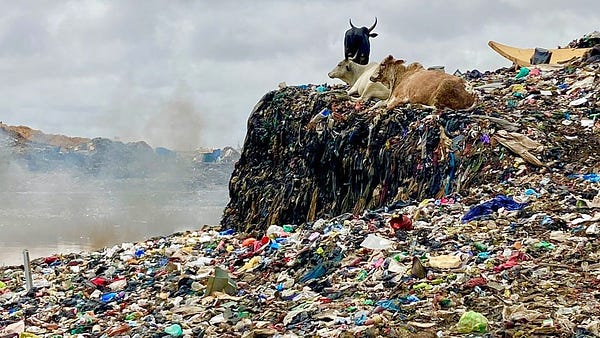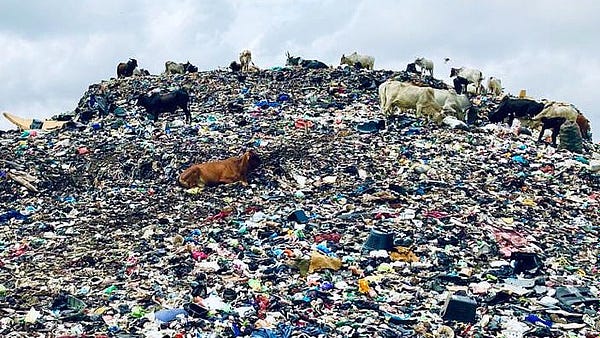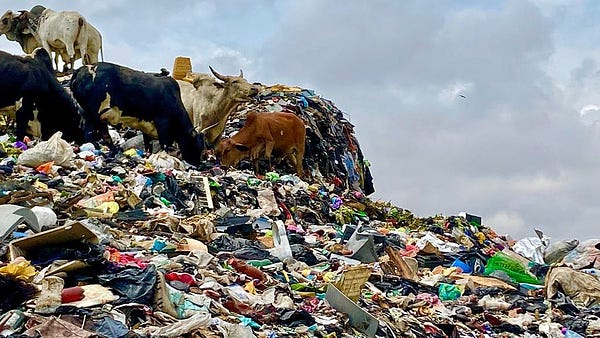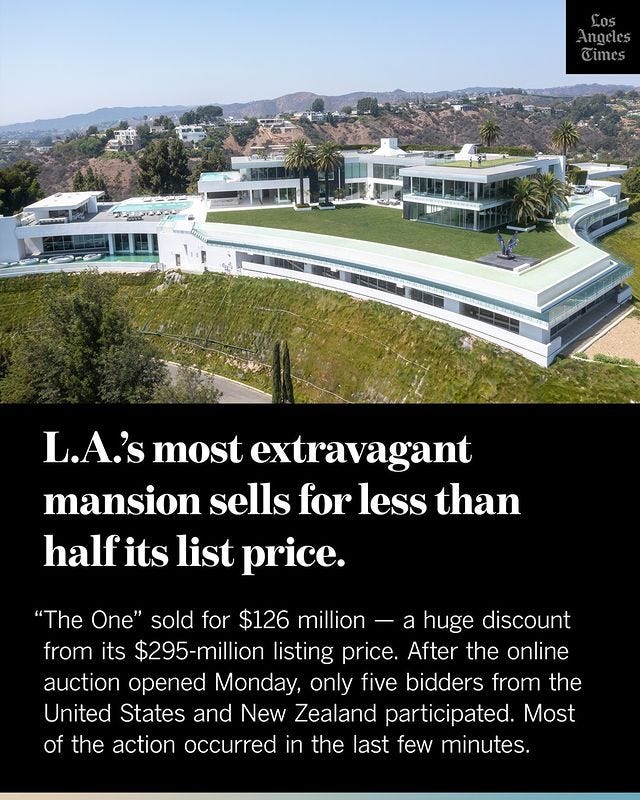Fashion Nova CEO Has Absolute Ton of Money
He is spending $141 million on a mega-mansion in Los Angeles called "The One."
Thank you for subscribing to Back Row. My second book ANNA: The Biography comes out May 3 and was chosen as one of Bloomberg Businessweek’s 10 most compelling books to put on your reading list this spring. James Tarmy writes, “The secret to [Anna’s] longevity is the subject of Odell’s biography, which is drawn from interviews with Wintour’s tightknit inner circle. Given that she’s famously private and notoriously aloof, the participation of intimates in the book’s reporting indicates a green light from Wintour herself. But Odell is unsparing, detailing Wintour’s ambitious rise and ruthless power grabs, dotting the narrative with a healthy amount of gossip and color.” Preorder the book on Amazon or wherever you like to buy your books. It’s out May 3 and your preorders will enable me to keep this newsletter available to read for free. If you are new here, please tap subscribe to get more stories like this one sent to your inbox about twice a week.
A piece of real estate in Los Angeles known as “The One” just sold for $141 million. It is 105,000 square feet and was listed as a residence, but is clearly an office building for a consortium of YouTube creator collectives. Just look at this L.A. Times photo of its “floating lounge” and tell me this water has been both chlorinated within the last three years and graced by human beings who subsist on foods other than sugar cereal in oat milk.
One can surely understand the appeal of such a glamscape for the late teen creator set. Content filmed here will fool anyone over the age of 50 into thinking you are a Jenner. And when you trash out one bathroom, you don’t have to clean it, because you have 41 more to choose from. From the L.A. Times:
Although some in the L.A. real estate community have dismissed the residence as garish, others have seen it as the ultimate trophy home — with a list of amenities aimed at the party set. There is a sky deck with cabanas, multiple pools, a private theater, a bowling alley, a billiard room, a candy room, salon and spa as well as a nightclub. It has 21 bedrooms and 42 full bathrooms.
The winning bid of $126 million was less than half the $295 million list price. It’s also considerably less than the L.A. real estate record set when venture capitalist Marc Andreessen picked up a place in Malibu for $177 million, which was $12 million more than a previous record set by wild New Year’s yacht man Jeff Bezos. (The $141 million total price of “The One” includes a 12 percent auction fee of $15 million. You know what everyone’s mom says about having $15 million — don’t blow it all on one auction fee!) How did such a home come into existence? Tell us, L.A. Times:
The One, which already has been rented out for filming, is the magnum opus of flamboyant developer Nile Niami. He initially marketed the home for $500 million several years ago but was forced to put it into bankruptcy after Crestlloyd, the home’s limited liability company, defaulted on $106 million in construction loans to L.A. billionaire Don Hankey.
Let’s think about who might buy such a home, because it clearly hasn’t sold to a consortium of content creators. You don’t read about things like this and see names like Jake Paul or Addison Rae in the mix with Jeff Bezos and Marc Andreesson. Who might be interested in buying something as extravagant as it is shady at a price that is this much lower than the item’s value? If the person coming immediately to mind for you is the CEO of internet fast fashion juggernaut Fashion Nova, you are correct.
His name is Richard Saghian. You can find him on Instagram under the handle @rich. He seems like a #livelaughlove #bro — his sparsely populated feed includes a couple of man memes (“WHEN I LOST ALL OF MY EXCUSES I FOUND MY RESULTS”). There are also photos of him in what appears to be a private plane (posted in September of 2020 when the world had gone to hell yet he was having “the summer I needed”) and a helicopter (“had to beat the traffic”). His TikTok feed has the same handle and contains a single video which I don’t recommend watching if you’re not in the mood to see people popping bottles on a ski slope to techno music, going “WOOOOO!!!”
Lacking in his feed are scenes of his other homes, including the Malibu beach place he bought from Netflix CEO Ted Sarandos for $14.7 million, which I think we can all agree that, at less than his auction fee for The One, was a straight steal. He also spent $17.5 million on another house in the Hollywood Hills in 2018. It might sound extreme to own three mansions in a single metropolis, but the traffic in L.A. is BAD, you guys. Even I know that as someone who has lived in New York for 18 years.
There’s not much out there on Saghian, who is 40 years old. In a ProQuest search of newspaper and magazine archives, the oldest story about him that comes up is a 2018 Women’s Wear Daily profile by Aria Hughes. He previously talked to Mariah Smith when she wrote about wearing Fashion Nova for a week for The Cut in 2017. But he’s been only marginally more available to the media than Amancio Ortega, the fast fashion magnate who started Zara in 1975 and is today one of the richest people in the world. In her excellent book Fashionopolis: Why What We Wear Matters, Dana Thomas reports on Zara’s rapid expansion following its 2001 IPO — along with the company’s secrecy:
The IPO windfall would help underwrite expansion. Between 2001 and 2018 — as trade barriers tumbled and globalization hit its stride — Zara rolled out nearly 1,700 new stores, for a total of 2,200, in ninety-six countries…
All the while, [Zara parent company] Inditex remained relatively hidden from view. No interviews. No advertising. No photographs — not even of Ortega; there are very few public images of him… One of my friends, a former business writer for Women’s Wear Daily, told me he called Inditex headquarters almost every day for ten years to request an interview; every day he was told, “Not now.”
Saghian’s father operated women’s retail stores, and he spent summers working in them, inspiring him to get into the business himself. He opened Fashion Nova as a retail store in 2006 at the Panorama Mall in Panorama City, California. Around seven years later, he noticed that online stores were doing pretty well in his category, and started mulling one of his own. He knew he would have to direct customers there somehow, and decided that Instagram — he accrued 60,000 followers before the online store went up — would be a good way to do that. After all, his customers were already taking pictures of themselves wearing Fashion Nova and tagging the store. Saghian decided to give them free product in exchange for Instagram promotion. After the store went live in 2013, he sold out of everything in a weekend.
Fashion Nova kept investing in Instagram marketing. Most of its influencer partners just got free clothes, but some, like Cardi B and Kylie Jenner, were paid. Cardi B received $20,000 a month for promoting Fashion Nova, WWD reported. In that 2017 story, Saghian told The Cut that a post from Kylie Jenner — whose fee he did not disclose — could drive $50,000 in sales. Fashion Nova is known for carrying clothes that fit a wide range of sizes and body types, especially its popular jeans, which cost around $35, which means that one Jenner post could lead to the sale of upwards of 1,400 pairs.
Saghian told WWD that variety was a big part of Fashion Nova’s success: “We don’t want girls showing up to the club in the same outfit. We need 50 different denim jackets. Not just one.”
WWD asked Saghian why, after avoiding media attention all these years, he was submitting to their interview which “clearly [made] him uncomfortable.” He seemed to do as much as he could to ensure that this wasn’t a typical interview:
He dismisses the idea of a portrait photograph to accompany this story and he has on a very low-key, trend agnostic outfit: a denim shirt worn unbuttoned over a T-shirt, jeans and a black chunky watch with gold accents that looks expensive, but isn’t ostentatious.
Saghian also likes to speak in talking points and grand themes that aren’t always conducive to a free-flowing conversation with a reporter. He says things like “overpriced fashion is dead” and “Fashion Nova is the fastest-growing women’s apparel company.” To help guide the interview, which took place in a conference room at Fashion Nova’s headquarters right outside of downtown Los Angeles, he referred to an Excel sheet of questions he’s received from this journalist and other reporters over the past few months, which were coupled with very prepared, corporate answers.
He said he was doing the interview “for recruitment.” At the time, he had around 20 open jobs. Employee perks then included a Fashion Nova discount and free donuts on Fridays.
Fashion Nova remains privately held, and Saghian said in that 2018 interview that the company was profitable, but did not say by how much. This was the same year that he bought the $17.5 million Hollywood Hills place, though, and he noted, “I could stop it right here and live a good life, but I want to grow the business.”
Shortly after the WWD story came out, the AP reported that Fashion Nova churned out around 600 to 900 new styles each week and employed around 600 people. Multiple articles from this period describe Fashion Nova’s influencer network as including more than 3,000 people.
Grandiose visions of becoming something like the Jeff Bezos of fast fashion might have been the subtext of him more or less outright insulting Amazon in WWD:
“We don’t need to work with Amazon. Our customer comes to our site,” said Saghian, who added that millions of visitors shop Fashion Nova each month. “And most girls don’t want to tell their friends they bought a dress from Amazon.”
In June, he did another interview at Fashion Nova HQ, this time with Allison P. Davis of The Cut, who wrote that when she asked him why the company was successful, he said, laughing, “I don’t know. We sell really dope shit?” Also:
He asks a member of his publicity team for a Red Bull, then pauses and muses aloud whether his beverage choice will be on the record. He opts for water instead. He’s joking with me, sort of, but the interview sets him on visible edge. While he sells clothes for people who love to bare as much as humanly possible on social media, he himself prefers extreme privacy. Every interview he’s given — Vice, WWD, BuzzFeed — there’s a moment where he expressed discomfort with being interviewed or just bluntly said: “I rarely give interviews,” like he’s the Howard Hughes of spandex clothing. When asked questions about, basically, anything: his life, why the company is called Fashion Nova, if it is Thursday or Friday, Saghian deflects. “Can I answer that later,” he asks, or switches to a tenor precisely calibrated for giving a Powerpoint presentation at an investor lunch.
Davis also spent time with Nova Babes, the network of influencers who promote the brand on Instagram, reporting that they usually do this in exchange for “clothes, followers, and discount clothes” rather than a paycheck. The prize for an Instagram contest awarded to ten Nova Babes around this time was a two-night trip to L.A. for “a photo shoot, full glam, time with the Fashion Nova team, and two nights of dinner and clubbing.”
In an excerpt from her book Get Rich or Lie Trying: Ambition and Deceit in the New Influencer Economy that ran recently in The Guardian, Symeon Brown also discusses Nova Babes. The article is titled, “Hustle and hype: the truth about the influencer economy,” with the subhed, “More and more young people are enticed by the glittering promises of a career as an influencer – but it’s usually someone else getting rich.” It reads:
Fashion Nova invites aspiring influencers to buy and model its clothes, then tag their photos @fashionnova and #NovaBabe. More than 10m posts have been made by ordinary young women auditioning to get the brand’s attention. Each is hoping to become a paid “NovaBabe”, an ambassador who receives free clothes, the Instagram equivalent of being on the VIP table.
…Many aspiring influencers pay for hauls of Fashion Nova clothes to review and model, viewing it as an investment in what they hope will become a job. In reality, they’re providing the company with free labour as promo girls, giving the brand adverts they did not have to pay for.
And what about the much less visible Fashion Nova workforce that makes the clothes? In that 2018 story, WWD reported the company had more than 1,000 manufacturers and that 80 percent of the clothes were made in L.A. during the summer, and 80 percent overseas “during the colder months.” In 2019, the New York Times reported that the federal Labor Department had found many of those U.S. workers were paid “illegally low wages.” The paper explained that investigators make annual unannounced visits to garment factories in L.A., such as those that make Fashion Nova clothes, to talk to workers and review payroll:
In investigations conducted from 2016 through this year, the department discovered Fashion Nova clothing being made in dozens of factories that owed $3.8 million in back wages to hundreds of workers, according to internal federal documents that summarized the findings and were reviewed by The New York Times.
One source said that some sewers were paid just $2.77 an hour. The Times interviewed Mercedes Cortes who worked at a factory making Fashion Nova clothes where she was paid pennies for each top she made that was then sold for $12. “The clothes are very expensive for what they pay us,” she said.
The Times reported less than half of Fashion Nova clothing was being made in L.A. in 2019, but the company wouldn’t say how much was made in the U.S. Companies like Fashion Nova often say they aren’t responsible for what happens in these factories, given they aren’t contracted directly, but rather subcontracted. Fashion Nova’s general counsel told the Times the company “is not responsible for how these vendors handle their payrolls.”
A release posted to the Labor Department’s site dated May 11, 2021 concerns the investigation of a factory called Sew Nice, which made Fashion Nova clothing:
The investigation will result in the recovery of $5,846 in back wages to 10 employees. The garment contractor will also pay $3,485 in penalties because of the willful nature of the violations found.
Saghian, meanwhile, was driving a Rolls Royce — which has an opening price point of a few hundred thousand dollars — at least as of June 2021. (The make of his car was reported in the media after it was targeted in an armed robbery one night around 2 a.m. outside his Hollywood Hills home, which resulted in five people being shot and one person dying.)
In its story this week about his purchase of “The One,” the L.A. Times reported that a source said the still privately held Fashion Nova does annual sales of more than $1 billion. Despite being media-averse, Saghian issued a statement to the L.A. Times about buying the house.
“The One Bel-Air is a once-in-a-lifetime property that can never be duplicated. There is nothing else like it. As a lifelong Angeleno and avid collector of real estate, I recognized this as a rare opportunity that also lets me own a unique property that is destined to be a part of Los Angeles history,” Saghian said Sunday in an emailed statement.
It’s weird that he would bother saying anything about buying the house, right? After all, this is a guy who wasn’t sure if he wanted us to know that he drank Red Bull in the middle of the day at his office. Then again, think about all the other things reporters might ask him about — like the thousands of Instagram influencers working on their Fashion Nova photos in exchange for cheap clothing instead of money, or the garment workers earning less than $5 an hour making the clothes, or the communities in places like Ghana that will be impacted the most when these are discarded after a wear or two.




Buying the biggest house in Los Angeles would strike many as an uncomfortable claim to fame in 2022. But for someone like Saghian, it probably beats having to answer detailed questions about his business.
Please don’t forget to subscribe to Back Row if you haven’t yet.




